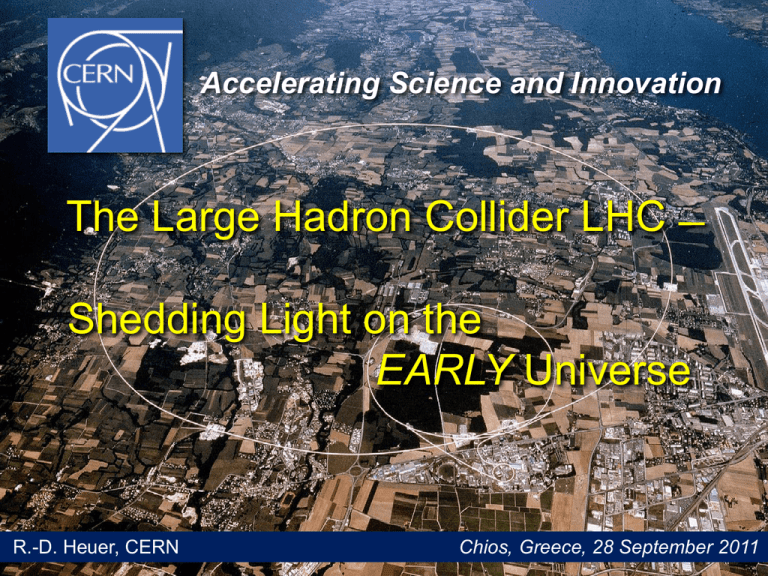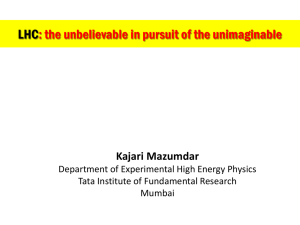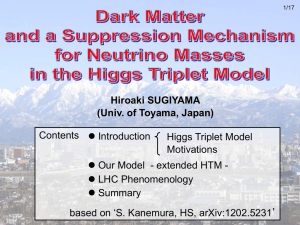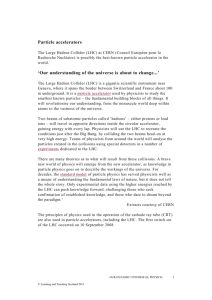heuer-chios-public-2011
advertisement

Accelerating Science and Innovation The Large Hadron Collider LHC ˗̶ Shedding Light on the EARLY Universe Glion Colloquium / June 2009 R.-D. Heuer, CERN 1 September 2011 Chios, Greece, 28 Particle Physics at accelerators Explore the innermost structure of matter : • Which are the fundamental constituents of matter ? • Which forces interact between them ? Investigating the Structure of Matter ↓ Understanding the Early Universe The role of accelerators high energy: Resolving the inner structure of matter: Production of new Particles : high statistics (= high “luminosity”): Precision measurements E = hc/λ E = m c2 Energy ? acceleration through electric voltage 1 TeV = 1.000 GeV = 1.000.000.000.000 eV LHC energy: 2 x 7000 billion batteries 14 batteries per star in Andromeda galaxy Vision terascale • Revolutionary advances in understanding the microcosm • Connect microcosm with early Universe Big Bang Superstrings ? Unified Forces Inflationary Expansion Separation of Forces Time Energy 10-43 s 10-35 s 10-10 s 1017 TeV 1013 TeV 1 TeV Nucleon Formation 10-5 s 150 MeV Formation of Atoms 300 000 years 1 eV Formation of Stars 109 years 4 meV Today 15∙109 years 0.7 meV Particle Physics at the Energy Frontier with highest collision energies ever will change our view of the universe Big Bang Proton Atom Radius of Earth Earth to Sun Radius of Galaxies Universe LHC Super-Microscope Hubble Study physics laws of first moments after Big Bang increasing Symbiosis between Particle Physics, Astrophysics and Cosmology AMS ALMA VLT matter particles t c u charm d s top up down . ne e-neutrino e electron strange . nm b bottom m-neutrino m muon plus corresponding antiparticles . nt t-neutrino t tau Structure of Matter I Matter (Stars <=> living organisms) consists of 3 families of Quarks and Leptons Matter around us: only 1 of the 3 families Matter at high energies: ‚democratic‘, all 3 families present —> High Energy: Situation fraction of seconds after the creation of the Universe —> Study of Matter at High Energies knowledge about Early Universe Forces Gravitation (acts on mass, energy) Electromagnetic Force (acts on el.charge) Weak Force (acts on leptons, quarks) Strong Force (acts on quarks) Force Carriers = Gauge Bosons Graviton Photon W +/- ,Z Gluon 0 Structure of Matter II 4 fundamental forces act between Matter Particles through the exchange of Gauge Bosons (Gluon, W und Z, Photon, Graviton) Within our Energy regime: resp. strengths of forces very different At high Energies: all forces of same strength one force ? —> High Energy: Situation fraction of seconds after the creation of the Universe —> Study of the Forces at High Energies knowledge about Early Universe What have we learned the last 50 years or The “Discovery” of the Standard Model The physical world is composed of Quarks and Leptons (Fermions) interacting via force carriers (Gauge Bosons) Last entries: top-quark 1995 tau-neutrino 2000 12 Structure of Matter III Standard Model of Particle Physics Mathematical formalism describing all interactions mediated through weak, electromagnetic and strong forces Test of predictions with very high precision experimental validation down to ~10 -18 m or up to O(100 GeV) Fantastic achievement . . . however . . . one piece missing within Standard Model THE missing cornerstone of the Standard Model What is the origin of mass of elementary particles? Possible solution: Mass = property of particles with energy E to move with velocity v/c = (1-m2/E2)1/2 i.e. the higher the mass the lower the velocity (at the same energy) introduction of a scalar field (Higgs-Field) named after particles acquire mass through Peter Higgs interaction with this Higgs-Field Self interaction of this field → Higgs-Particle THE missing cornerstone of the Standard Model What is the origin of mass of elementary particles? Possible solution: Mass = property of particles with energy E to move with velocity v/c = (1-m2/E2)1/2 introduction of a scalar field (Higgs-Field) named after particles acquire mass through Peter Higgs interaction with this Higgs-Field Self interaction —> Higgs-Particle Higgs-Particle = last missing cornerstone within SM but: Does the Higgs-Particle exist at all ?? Key Questions of Particle Physics origin of mass/matter or origin of electroweak symmetry breaking with Supersymmetry unification of forces fundamental symmetry of forces and matter what happened to antimatter w/o Supersymmetry number of space/time dimensions Energy in GeV what is dark matter what is dark energy The LHC will address most of these questions . . . . in particular...... Standard Model THE ENERGY DENSITY BUDGET B CDM n DE BARYONS COLD DARK MATTER NEUTRINOS DARK ENERGY TOT B CDM n DE with the Large Hadron Collider at the Terascale now entering the ’Dark Universe’ the Large Hadron Collider (LHC) • Largest scientific instrument ever built, 27km of circumference • >10 000 people involved in its design and construction • Collides protons to reproduce conditions at the birth of the Universe... ...40 million times a second at Accelerating Science and Innovation 24 One of the coldest places in the Universe… With a temperature of -271 C, or 1.9 K above absolute zero, the LHC is colder than outer space. 25 One of the hottest places in the galaxy… The collision of two proton beams generates temperatures 1000 million times larger than those at the centre of the Sun, but in a much more confined space. 26 Proton-Proton Collisions at the LHC 2808 + 2808 proton bunches separated by 7.5 m → collisions every 25 ns = 40 MHz crossing rate 1011 (=100 billion) protons per bunch at 1034/cm2/s ≈ 35 pp interactions per crossing pile-up → ≈ 109 pp interactions per second !!! in each collision ≈ 1600 charged particles produced enormous challenge for the detectors Enter a New Era in Fundamental Science Start-up of the Large Hadron Collider (LHC), one of the largest and truly global scientific projects ever, is the most exciting turning point in particle physics. CMS LHCb Exploration of a new energy frontier Proton-proton collisions up to E = 14 TeV (this year running at E = 7 TeV) ALICE LHC ring: 27 km circumference ATLAS Spain and CERN / 28 the largest and most complex detectors Methodology To select and record the signals from the 600 million proton collisions every second, huge detectors have been built to measure the particles traces to an extraordinary precision. ATLAS through first data Fabiola Gianotti (on behalf of the ATLAS Collaboration) ATLAS, 18-12-2009 30 Example process at LHC m4μ=201 GeV CMS g W/Z g W/Z 31 Cross Section („Production Rate“) of Various Processes More than 10 orders of magnitude difference between total reaction rate and rate of new physics select 1 out of much more than 10 billion . . . The LHC experiments: about 100 million “sensors” each [think your 6MP digital camera... ...taking 40 million pictures a second] ATLAS five-story building CMS Balloon (30 km) LHC DATA CD stack with 1 year LHC Data! (~ 20 km) online computers filter out from 40 MHz rate a few hundred “good” events per sec. these are recorded on disk and magnetic tape at 100-1,000 MegaBytes/sec ~15 PetaBytes per year for all four experiments Mt. Blanc (4.8 km) Grid Computing and CERN Astronomy & Astrophysics Civil Protection Computational Chemistry Comp. Fluid Dynamics Computer Science/Tools Condensed Matter Physics Earth Sciences Finance Fusion High Energy Physics (WLCG) Humanities Life Sciences Material Sciences Social Sciences 285 sites in 48 countries ~250k CPU cores ~100 PB disk Large number of users 1M jobs/day EGEE-III INFSO-RI-222667 The New Territory We are poised to tackle some of the most profound questions in physics: “Newton’s” unfinished business… what is mass? Nature’s favouritism… why is there no more antimatter? The secrets of the Big Bang… what was matter like within the first c moments of the Universe’s life? Science’s little embarrassment… what is 96% of the Universe made of? ready to enter the Dark Universe Dark Matter Astronomers & astrophysicists over the next two decades using powerful new telescopes will tell us how dark matter has shaped the stars and galaxies we see in the night sky. Only particle accelerators can produce dark matter in the laboratory and understand exactly what it is. Composed of a single kind of particle or more rich and varied (as the visible world)? LHC may be the perfect machine to study dark matter. Beyond the Higgs Boson Supersymmetry: A New Symmetry in Nature Candidate Particles for Dark Matter Produce Dark Matter in the lab SUSY particle production at the LHC 39 Picture from Marusa Bradac Looking for Dark Matter χ01 No Supersymmetry yet! . . . But potentialMissing for discovery energy of SUSY sizeable even at LHC start-up taken away by dark matter particles LHC results should allow, together with dedicated dark matter searches, • around 73% of the Universe is in some first discoveries in the dark universe mysterious “dark energy”. It is evenly spread. Challenge: get first hints about the world of dark energy in the laboratory The Higgs is Different! All the matter particles are spin-1/2 fermions. All the force carriers are spin-1 bosons. Higgs particles are spin-0 bosons (scalars). The Higgs is neither matter nor force. The Higgs is just different. This would be the first fundamental scalar ever discovered. The Higgs field is thought to fill the entire universe. Could it give some handle of dark energy (scalar field)? Many modern theories predict other scalar particles like the Higgs. Why, after all, should the Higgs be the only one of its kind? LHC can search for and study new scalars with precision. Higgs-Boson at 7 TeV g Not enough data yet H Interesting in 2011 and 2012! g CMS W/Z W/Z m4μ=201 GeV Higgs-Boson at 7 TeV Excellent performance of Collider, Experiments, Computing end 2012 the question will be answered on the Higgs: to be or not to be CMS m4μ=201 GeV In other words... (G.Altarelli, LP09) LHC results will allow to study the Higgs mechanism in detail and to reveal the character of the Higgs boson This would be the first investigation of a scalar field This could be the very first step to understanding Dark Energy Past decades saw precision studies of 5 % of our Universe Discovery of the Standard Model The LHC delivers data We are just at the beginning of exploring 95 % of the Universe Past decades saw precision studies of 5 % of our Universe Discovery of the Standard Model The LHC delivers data We are just at the beginning of exploring 95 % of the Universe the future is bright in the Dark Universe






